Posted: September 29th, 2015 | No Comments »
Out this week and with an essay by me on Dragon Ladies and Rohmer….available from the Strange Attractor web site and soon all over
Lord of Strange Deaths: The Fiendish World of Sax Rohmer
Edited by Phil Baker & Antony Clayton
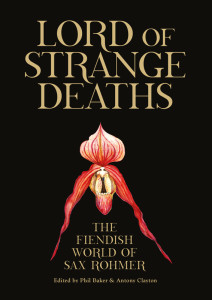
Forever associated with his creation of evil genius Dr Fu Manchu, a Chinese super-criminal scheming to destroy Western civilisation, Sax Rohmer (1883-1959) was the king of pulp exotica. At the height of his fame Rohmer was one of the most popular writers on the planet, but now he is largely remembered for outrageous attitudes and lurid Chinaphobia. Lord of Strange Deaths approaches Rohmer with something more than routine disapproval, and instead brings out the complexity and historical significance of his work.
This is the first extended attempt to do justice to Rohmer, and it ranges across the spectrum of his output from music-hall writing to Theosophy. Contributors focus on subjects including Egyptology, 1890s decadence, Edwardian super-villains, graphic novels, cinema, the French Situationists, Chinese dragon ladies, and the Arabian Nights. The result is a testimony to the enduring fascination and relevance of Rohmer’s absurd, sinister and immensely atmospheric world.
Contributions from:
Jean Augris • Phil Baker • Clive Bloom • Antony Clayton • Gary Dickinson • Christopher Fowler • Christopher Frayling • Paul French • Robert Irwin • Lawrence Knapp • Gary Lachman • Roger Luckhurst • Alan Moore • Steve Moore • Kim Newman • Kevin O’Neill • Mark Valentine • Anne Witchard.
Posted: September 28th, 2015 | No Comments »
Rather jerry-built structures in Shanghai are, it appears, nothing new. Here’s a rather hastily erected British troop bunker designed to defend the Settlement in 1937. Obviously they could fire from ground and raised level and it had a pretty heavily sandbagged frontage, though I doubt the rotunda on top would withstand a tank shell! Sadly, I do not know the exact location of this bunker….

Posted: September 27th, 2015 | No Comments »
We see a lot of pictures of western, Chinese and Sikh police and soldiers in old Shanghai – far fewer Annamite soldiers who worked and served in the French Concession. This picture is from 1940 and is of an Annamite soldier guarding Shanghai’s “Newspaper Row” (Avenue Edward VII) – I’ll blog on the attacks on “Newspaper Row” imminently. Annamite soldiers may have been in Shanghai earlier but certainly the 3rd Regiment of Tonkinese Rifles was posted to Shanghai in 1915, another company was sent to the city in 1927 during the disturbances. Anyway, here’s “A tough little French Annamite” on Avenue Edward VII (Yan’an Road today and the elevated highway)….
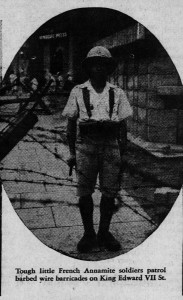
Posted: September 26th, 2015 | No Comments »
Some random Yellow Peril pulp covers for your Saturday…..




Posted: September 25th, 2015 | No Comments »
A new exhibition at New York’s Museum of Chinese in America…
PS: More on Poy Gum Lee here in the New York Times
And, more relevantly to this blog, here from Shanghai Art Deco on his Shanghai work (including the old YMCA below with its ornate Chinese roof – now crowded in but once standing majestically)….

September 24, 2015 – January 31, 2016

In this survey exhibition, architectural historian Kerri Culhane documents and explores Poy Gum Lee’s (1900-1968) nearly 50-year long career in both China and New York and examines Lee’s modernist influence in New York Chinatown. This project will result in the first-ever comprehensive list of Lee’s projects in New York. Lee’s hand is visible in the major civic architecture of Chinatown post 1945, which blends stylistically Chinese details with modern technologies and materials. Lee was the architectural consultant for the Chinese Consolidated Benevolent Association’s building on Mott Street (1959) and the On Leong Tong Merchant’s Association at Mott & Canal Street (1948-50) – the most prominent Chinese modern building in Chinatown. Among his highly visible commissions, Lee designed the Chinese-American WWII Monument in Kimlau Square (1962), a modernist take on a traditional Chinese pailou, or ceremonial gate; the Lee Family Association (ca. 1950); and the Pagoda Theatre (1963, demolished).

Posted: September 25th, 2015 | No Comments »
Amazing to think the Beijing Bookworm has been ten years up those steep, steep steps of Nan Sanlitun! And so a brief trip down memory lane….
In those ten years I got to be on quite a few panels as well as moderating a host of great writers including Louise Welsh on Naming the Bones, Carol Birch on Jamrach’s Menagerie, Chris Womersley on Bereft, Qiu Xiaolong on Inspector Chen, Guy Delisle on Pyongyang, Michel Faber on The Crimson Petal and the White, Barbara Demick on North Korea, Catherine Sampson on Robin Ballantyne, Ridley Pearson on writing multiple bestsellers, Jonathan Fenby on warlord China and Yrsa Sigurðardóttir on Icelandic crime among others….
Plus, over the years, the Bookworm invited me to talk about foreign journalists in China, Carl Crow, the old Peking Badlands, Midnight in Peking and the Pamela Werner murder (which was originally a short story in the Bookworm’s own 2008 publication Beijing: Portrait of a City) and even Andre Malraux’s Man’s Fate one year. Penguin China kindly launched Midnight in Peking on the roof one hot August night and, after I decided to adapt Lao She’s short story Ding into a one-man monologue, we transformed the stage area into a Qingdao beach for a night!!
 Chatting with Carol Birch about her novel Jamrach’s Menagerie in 2012
Chatting with Carol Birch about her novel Jamrach’s Menagerie in 2012
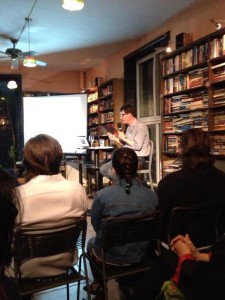 Talking murder, mayhem, opium and all round Peking Badlands badness…
Talking murder, mayhem, opium and all round Peking Badlands badness…
 With Qiu Xialong and Cathy Sampson talking criminal minds in 2009
With Qiu Xialong and Cathy Sampson talking criminal minds in 2009
 Up on the roof launching a book one hot August night in 2012
Up on the roof launching a book one hot August night in 2012
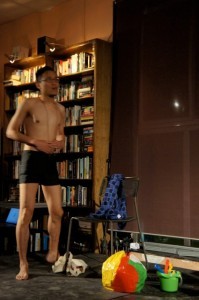 You have to admit local actor Wang Xuankun was up for it to play Lao She’s Ding…on his own, with my script, in his trunks!!
You have to admit local actor Wang Xuankun was up for it to play Lao She’s Ding…on his own, with my script, in his trunks!!
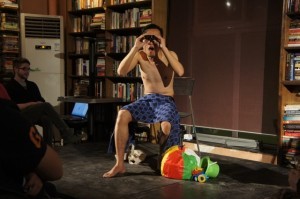 Clearly one of the more bizarre performances to graze the stage of the Bookworm in the last decade!!
Clearly one of the more bizarre performances to graze the stage of the Bookworm in the last decade!!
Posted: September 24th, 2015 | No Comments »
The rather horrible parade in Beijing the other week reminded me of Carl Crow’s wartime diaries (still available by the way here in the UK and here in the USA) …..And so an extract below that encapsulates more the reality of the war in Chungking, the raids and the daily life of the wartime capital that all got rather missed in the recent nationalism exercises in Tiananmen…..
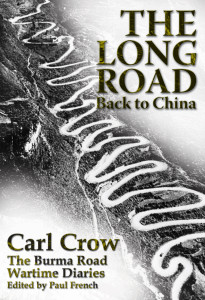
Chungking, Wednesday, June 7th 1939.
I was too tired to stay up even for an air raid and soon went to sleep, but I was awoken frequently. I think it must have been too many cigarettes rather than worry over the raid. The house boy told me this morning that the planes passed close, “but have go other place.†The Chinese tell me it takes three and a half hours for the bombers to fly from Hankow to Chungking. They have a gas supply for 12 hours so that on the round trip they have a leeway of five hours in which to lay their exploding eggs, escape the pursuit planes and return. It’s very foggy this morning but the sun is breaking through so it may be clear this afternoon. I am full of aches, which I suppose is on account of my cold. More gossip flows in – Mrs. Wang told me that General Feng speaks with a salty humor that can’t be translated; American born Geraldine Skinner Wong has married a Chinese; our military spokesman today will be General Chang Jo-ping; a useful man from the Ministry of Economics is Dr. Lin Chi-yin; the cotton mill we visited the other day is called Tu Feng.
There is much talk of the financial collapse of both China and Japan. Certainly if the war continues it is only a question of which one will collapse first. But if the current quotations of the two currencies are any indication, then China is standing the strain better than Japan. The yen has been constantly slipping and is now worth only about 90% of the Chinese dollar. At 10 o’clock I called on the Secretary of the Women’s Committee of the New Life Movement. It was not a very satisfactory meeting and she displayed the usual indifference to figures and no one would even guess how many orphans are being cared for. This organization has a quota of 20,000, which it will soon reach. It is probably the charitable thing to say that they are all so busy that they haven’t had time to co-ordinate their reports. When I told her about visiting an orphanage she immediately asked whether or not they had been told that we were coming?
Chungking is a city of hills laid out with no regard for anything but pedestrian traffic. The skyline was so overcast at 4 o’clock that it looked like dusk and I felt sure that we were free from air raids for another day. Then at 5:45 the whistle blew. Holly Tong had been insistent that at the next raid I go to the Foreign Minister’s dugout so I asked where it was, thinking that if it were in the neighborhood I might walk around to it. They all insisted that it was too far to walk and before I knew what they were doing they had telephoned the Minister’s house and a car was on its way.
I walked down the street to meet it. As on the occasion of the other raid there was no apparent confusion. Everyone hurried but everyone knew where he was going. I passed the entrance to the public dugouts and they did not appear crowded. At the Minister’s house servants were covering the parked cars with cloth and matting. Some little girl next door was doing finger exercises on the piano and having some difficulty doing them. A boy brought me a tin of cigarettes and a cup of tea. Mr. and Mrs. Wu arrived. She looked even prettier than she had last Sunday. She went into the dugout with some other Chinese ladies while Mr. Wu and I stood outside to watch. He told me stories about Hitler and Mussolini. A half dozen other Chinese officials came in, including the Chinese Minister of Communications whom I had last seen on the Burma Road out of Chifon.
Chinese pursuit planes could be heard overhead and finally we saw three, six and finally 18. I couldn’t be sure because of the clouds. It has now been almost an hour since the alarm was given. Someone said that the first lot of Japanese planes had turned back but that a second lot was on the way. With all these pursuit planes in the air it appeared that there might be some thrilling fights and I had about made my mind up to stay outside and see the fun when we all got a thrill that was not on the program. A plane zoomed down past us and I wondered why anyone would be stunting in a power dive at a time like this. I saw the plane disappear over the edge of a hill and then it didn’t appear again. It looked like something was wrong. Then an American Governess said, “Is that a balloon?†It was just a speck but after a time we saw it was a parachute and could finally distinguish the man hanging from the ropes. It didn’t seem to me to be coming from the direction of the last plane and then I remembered seeing another plane that had apparently left the squadron on an independent flight of its own. So two Chinese planes may have been lost. Just then the all-clear signal was sounded. Apparently the show of force had frightened the Japanese away and the loss of two planes may have been a cheap price to pay for it. I walked back to the Guest House in less than ten minutes. The raid had lasted until 7 o’clock.
Posted: September 24th, 2015 | No Comments »
I’d never seen a Medaille Or de la Municipalite Francaise, the highest award from the French Concession Government. The obverse consists of the coat of arms or seal of the French Concession ringed with a banner reading “Concession Francaise de Changhai” There are tiny design credits of “L Mayol” to the left of the badge and “Paris Art” to the right of the badge. The reverse reads “Merite Civique”. There is also a punch mark on the rim between “concession” and “francaise” which reads 18K, an assay mark as to the gold content.
I’m not sure how many were given out by one was given to Colonel A.F. Marcaire, the long-serving Commander of French Armed Forces in Shanghai. His final campaign was to attempt to suppress Green Gang casinos in Shanghai. In 1932 he, along with some other French Concession dignitaries, was invited to Du Yuesheng’s (Big Eared Du, boss of the Green Gang) Rue Wagner mansion for dinner. Five attended – four, including Marcaire, died of poisoning, one managed to survive and left immediately for France while the host was fine and walked away from the table in perfect health!!


















